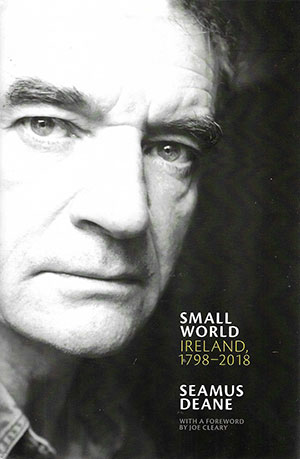SMALL WORLD: IRELAND, 1798–2018
Published in Book Reviews, Book Reviews, Issue 5 (September/October 2021), Reviews, Volume 29 SEAMUS DEANE
SEAMUS DEANE
Cambridge University Press
€28
ISBN 9781108892810
Reviewed by Vona Groarke
Vona Groarke is a poet and author. Her Link: poet and world will be published in October 2021 by the Galley Press.
When the published essay seems, so often now, to have the qualifier ‘personal’ attached, it is as refreshing as it is stimulating to encounter this collection of essays on a range of topics scantly lodged in the autobiographical. That Small world issues from the author of Reading in the dark, one of the first books of autofiction (before the term was current), may surprise readers not familiar with his previous essay collections. Only one essay in the recently, posthumously, published Small world (‘The Famous Seamus’, an account of Deane’s friendship with Seamus Heaney, written, colloquially and sociably, for The New Yorker) relies on the first person singular; others are, as one would expect of scholarly essays, framed within Seamus Deane’s particular combination of learning, intellect, principle and style.
This is not to suggest that Small world is a collection of impersonal essays: its through-line is a restless, forensic, acerbic and often impassioned critical imagination, coupled with an elegant (and often enjoyably waspish) writing style. But Seamus Deane—poet, novelist, scholar and (as the Foreword claims) ‘public intellectual’—is nothing if not a shapeshifting (but consistently commanding) presence in the world of Irish letters. If a synthesis of writerly élan and critical analysis was the hallmark of previous essay collections, Celtic revivals and Strange country, in the sixteen essays of Small world it is amplified to effectively frame a more extensive range of disparate subjects and concerns.
Some essays have been encountered before in their original iteration as pamphlets, essays or book chapters (the oldest, on Ulysses, reaches back almost 45 years); four—two on Elizabeth Bowen, one on Mary Lavin and one that includes an already controversial section on Anna Burns’s novel Milkman—are published here for the first time. Its array of subjects is dazzlingly wide and profoundly literary (if definitively committed to the political/historical and that resonant, back-slashing, distinction between them).
A reader new to the mind of Seamus Deane may find reason to recall Seamus Heaney’s description of him as ‘paradoxically both more cosmopolitan and parochial than himself’. The cosmopolitan may well arise from Deane’s scholarship of Enlightenment intellectuals, but the parochial (a little harder to account for) is perhaps here evidenced as a way of parsing literary texts in the context of perceived social or historical fault lines and their consequent conflicts of Irish cultural identity.
‘Mary Lavin: Celibates’, for example, would appear to be rather more interested in the social context of a 1950s and 1960s Ireland almost equally, punishingly, gripped by emigration and the Catholic Church than it is in stories themselves. The backdrop is foregrounded, and while an observation about widowhood as born-again virginity is undoubtedly eye-catching, there is a strong sense of a critical faculty alighting on the Lavin stories for evidence of an extra-literary argument perhaps a little too mercilessly.
But if the lens of the Mary Lavin essay might be said to be a little too wide, ‘Elizabeth Bowen: Sentenced to Death’ might be too narrow. In this examination of Bowen’s use of grammar, punctuation and syntax, particularly in The house in Paris, the subject doesn’t seem quite equal to the weight of critical pressure applied to it, so that the essay, in which obliquities of syntax are read as seeming ‘like pedantry’, seems itself guilty of the charge.
Satisfyingly, other essays get the title’s interplay of little and large, of close-up and panorama, just right. The close reading of ‘A Painful Case’ in ‘Dead Ends: Joyce’s Finest Moments’, for example, homes in on the final paragraph’s eight anaphoric sentences but unfurls that specificity into a larger point about ethics, isolation and irresponsibility. Similarly, the wonderful ‘Heroic Styles: The Tradition of an Idea’ pits the artist’s aestheticising individuality in adversarial relationship with notions of community and its freight of cultural tradition, using Yeats and Joyce to illustrate two possible artistic approaches—the either/or of adherence or separation. In either case, the artist is to be understood as artefact or exemplar of tradition rather than as originator. ‘Dead Ends’ rounds off its reading of Dubliners by noticing: ‘In all the stories in Dubliners other than “The Dead”, repetition has a critical and disturbing function. It has analytic and polemical power. In this final story, all that is surrendered for lyricism.’ In the (spurious) knockabout between polemic and lyric, Deane’s money is clearly on the heavyweight.
It’s an interesting take for a writer who published four poetry collections (his last being History lessons in 1983). The impulse may not, however, have been fully lost. The final, engrossing essay here, ‘The End of the World’, is structured as stanzas in a poem might be, with a series of individual sections, initially of named boats, then islands, then islands’ inhabitants. It observes, ‘The torpedo officer who pressed the button that sank the Lusitania was Raimund Weisbach who, six months later, was the captain of the U-19 that brought Roger Casement to Banna Strand on Good Friday 1916’. Despite his suspicion of lyricism, Deane’s eye for the telling detail is inherently poetic and unfailingly dramatic.
This way of establishing lines of connection, of synthesising argument and angling fresh light on familiar topics makes for a book of hugely impressive range and depth. Combative, earnest, erudite and urbane, Small world is a major achievement: a publication of significance and heft.
















